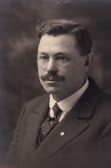My great grandfather came from Sweden to homestead in northeastern South Dakota in the late 1800s with his brothers. During my childhood, his farm was a home base for the family, and even today, is farmed by their descendants. My grandmother lived in north central Iowa, which is where I spent almost every summer growing up, and we would drive up to the farm in Redfield at least once every summer to visit family. Since then, my mother lost track of the South Dakota relatives, and although I have always been grounded by knowing they were there, I don't even know their names.
 |
| Gustav, Otto, Ole & Walter |
My great grandfather's farm never held debt because the U.S. government gave him and my uncles the land for free. They bought farm equipment together and shared it on their adjoining farms, keeping costs down. As a result, my grandfather and his brothers helped me and countless other cousins attend college, helped some relatives buy houses, and gave others the initial investment for small businesses of their own. They were never wealthy, and worked hard from sunup to sunset, but that boost from the government set up their family for middle class success in the 20th century and into the 21st.  |
My great grandfather, Otto Johnson,
on left, my mom at far right, Grandma
behind her, in Redfield |
Whenever I am in discussions about systemic racism in the U.S., I am keenly aware that this is a shining example of it. My grandfather and his descendants didn't harbor any racial animus that I am aware of, but the fact that he – and we – have directly benefited over and over from the generational stability provided by a government program (the Homestead Act) that was explicitly denied to Black Americans and designed to push out Native Americans means that we are part of that racist system. It is one reason my parents were involved in the Civil Rights movement, and a big part of why I have worked most of my adult life to combat racism and inequity.Even though we no longer know the family on the farm, I was determined that we travel through Redfield on our journey west this year. We dropped down from the North Dakota National Grassland, through the lovely small city of Aberdeen, into Redfield, which now touts itself as the Pheasant Capital of the World. It's a small town with a sleepy downtown and several unpaved streets. Still, I felt a certain connection there that I was glad I hadn't lost.




We headed next into the Black Hills, home to the country's largest gold deposit, but also some of the most spectacular scenery, iconic wildlife, and larger-than-life public art.
Our first stop (after spending the night in the Rapid City Camping World parking lot to avoid getting stuck in the mud at another wild camping spot) was Mount Rushmore – a monument that destroyed an Indian sacred place to create a tribute to four American presidents: George Washington, Thomas Jefferson, Teddy Roosevelt, and Abraham Lincoln. It's impressive as a work of engineering and vision, but also disturbing as a stark symbol of America's disregard for land and peoples.
We followed that by visiting Rushmore's antidote – Crazy Horse, a monument commissioned by Indians to honor their culture and history. I last saw Crazy Horse almost 50 years ago, when it was a vague shape in the mountain. Today, the face and hand are fully shaped, and work has begun on the horse. It's a multi-generational project, and I doubt we'll live to see it completed.
At the Crazy Horse monument, we enjoyed a cultural presentation of Indian dancers doing Men's Fancy, Shawl, and Hoop dances, with lots of background and explanation from the dancers. Turns out the Hoop dancer's dad spent a lot of time as young man in Redfield!
Finally, we turned up Spearfish Canyon to see gorgeous waterfalls on the Spearfish River as it cascades through cliffs and chasms before flowing out of the Black Hills. The river water was so clear you could see the expressions on the faces of the fish swimming by.And of course, if you know me at all, you'll know I was enchanted by South Dakota's fauna – bison, prairie dogs, pronghorn, and deer, and all the birds who serenaded our trip. Here are a few:
South Dakota awed and surprised us. I hope these pictures share even a tiny bit of that experience.























Comments
Post a Comment